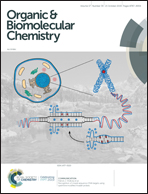Deeper insight into protease-sensitive “covalent-assembly” fluorescent probes for practical biosensing applications†‡
Abstract
We report a rational and systematic study devoted to the structural optimisation of a novel class of protease-sensitive fluorescent probes that we recently reported (S. Debieu and A. Romieu, Org. Biomol. Chem., 2017, 15, 2575–2584), based on the “covalent-assembly” strategy and using the targeted enzyme penicillin G acylase as a model protease to build a fluorescent pyronin dye by triggering a biocompatible domino cyclisation–aromatisation reaction. The aim is to identify ad hoc probe candidate(s) that might combine fast/reliable fluorogenic “turn-on” response, full stability in complex biological media and ability to release a second molecule of interest (drug or second fluorescent reporter), for applications in disease diagnosis and therapy. We base our strategy on screening a set of active methylene compounds (C-nucleophiles) to convert the parent probe to various pyronin caged precursors bearing Michael acceptor moieties of differing reactivities. In vitro stability and fluorescent enzymatic assays combined with HPLC-fluorescence analyses provide data useful for defining the most appropriate structural features for these fluorogenic scaffolds depending on the specifications inherent to biological application (from biosensing to theranostics) for which they will be used.

- This article is part of the themed collection: Chemical Biology in OBC


 Please wait while we load your content...
Please wait while we load your content...